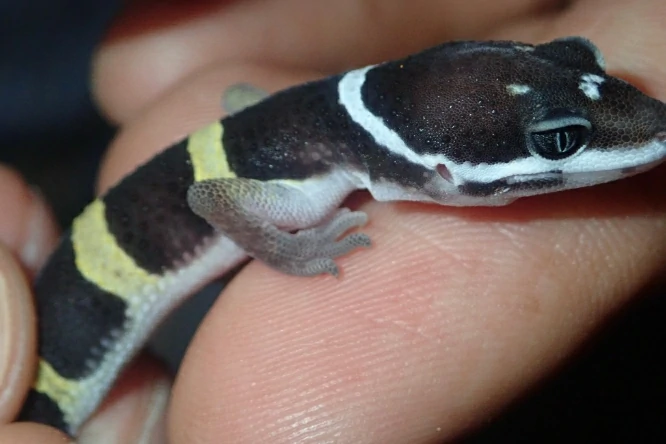If you’ve ever taken a close look at a gecko, you might’ve noticed something a bit odd. Right under their front legs (basically in their armpits) there are these tiny little holes.
At first, they just look like random dots or tiny gaps in their skin. You might even think they’re scars or part of their strange little body design. But actually, those holes are important.
They’re not there for decoration. They’re a tiny but powerful part of how geckos communicate and move around in their world.
So why do geckos have holes in their armpits?
Geckos have holes in their armpits because these are special pores called femoral or pre-anal pores that release pheromones they use to send signals to other geckos. These little pores help them “talk” to each other through scent, leaving messages about things like territory, mating, or identity. It’s like a secret language that humans can’t see or hear but means everything to a gecko.
Once you know what they do, it makes watching geckos way more interesting.
Every little stretch, rub, or movement might actually be part of their silent chemical conversation.
What Are These Holes, Really?
So first, let’s clear something up: these “holes” aren’t holes like you’d see in a wall. They’re more like tiny skin openings that lead to small glands underneath.
Scientists call them femoral pores if they’re on the thighs, or pre-anal pores if they’re closer to the base of the tail, near where the legs meet the body.
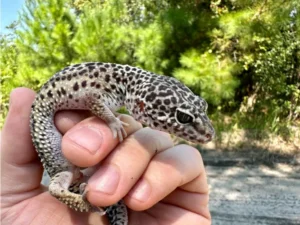
Inside those pores are tiny glands that make pheromones, which are special chemicals used for communication.
When a gecko rubs its body against something, like a rock or wall, it leaves a trace of those chemicals behind, kind of like leaving a little sticky note that says “I was here.”
Some species have strong pheromones that other geckos can pick up from far away. It’s like a scent trail or chemical message floating through the air.
To us, it’s invisible, but to them, it’s basically a social network written in smell.
How Do Geckos Use These Armpit Pores?
Geckos don’t just have these pores for no reason, they use them for all kinds of social stuff that helps them survive and get along.
Here’s what they’re used for:
-
Marking Territory – Male geckos often use these pores to claim an area. They’ll rub their thighs or tail base on rocks or branches to say, “This is my space.” That way, other males can smell the pheromones and know someone already lives there.
-
Finding a Mate – During breeding season, pheromones help geckos find each other. Females can sense which males are nearby, and males can pick up on signals that a female is ready to mate.
-
Identity Signals – Some geckos can tell each other apart just by the scent from these pores. It’s like having a personal ID card that says who they are.
These little holes do a lot more than you’d think. They let geckos send messages silently, without chirping or fighting.
When you watch geckos move around their enclosure or a wall outside, they’re not just walking, they might actually be writing invisible messages for other geckos to read later.
Do All Geckos Have These Holes?
Not every gecko has obvious armpit holes, but most species do. In general, males have larger and clearer pores than females, especially when they’re mature or during the breeding season.
Females might still have them, but they’re smaller and harder to see.
Even between males, the size, shape, and number of pores can vary depending on the species.
For example, leopard geckos have a clear V-shaped row of pores right in front of their vent (the opening under the tail), while crested geckos barely show any at all.
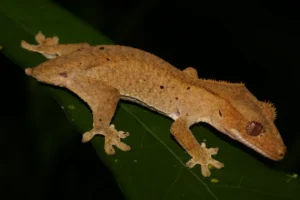
And here’s something cool: you can sometimes tell a gecko’s age or maturity by its pores.
Young geckos usually have tiny or invisible pores, which grow larger as they reach adulthood.
So next time you see a gecko, take a closer look. Those little dots near the legs aren’t random.
They’re actually a sign that the gecko is part of a quiet world full of messages we can’t even detect.
Why Are They Called “Armpit Holes”?
People call them “armpit holes” because they sit right under the front legs, basically where a human armpit would be. But that’s not what scientists call them.
The real names are pre-anal pores or femoral pores, depending on the exact spot they’re found.
Still, “armpit holes” is a pretty handy nickname, especially if you’re new to keeping geckos. It’s an easy way to explain where to look.
If you gently lift a gecko’s front leg, you might see a faint line of small dark spots or dots underneath the thigh or near the armpit area.
They might look like little pinholes or even tiny blackheads, but they’re completely normal.
How Do Geckos “Leave Messages”?
This is one of the coolest parts of all. Geckos don’t just sit around and hope their pheromones get noticed, they actively spread them.
When a gecko wants to leave a chemical message, it rubs its thighs, armpits, or tail base against surfaces like branches, rocks, or walls.
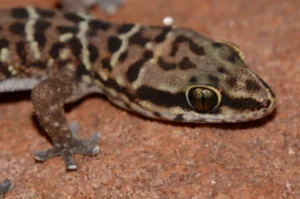
By doing this, they leave invisible chemical trails that other geckos can later detect. Males, especially, will mark the same spots repeatedly to make sure their scent stays strong.
Some even perform special movements, like tail-waving or body rubbing, just to make sure the message sticks.
These invisible “notes” can say things like:
-
I’m healthy and strong, stay out of my space.
-
I’m single and ready to mate.
-
I was here yesterday, and I’ll be back.
It’s all part of how geckos build territories, find mates, and avoid fights without making a sound.
Do Humans Have Anything to Worry About?
Not at all. Those tiny pores might look strange, but they’re totally harmless to people. The secretions aren’t toxic, and they can’t hurt you.
The only small risk comes from handling reptiles in general, not from the pores themselves.
Like with any reptile, it’s smart to wash your hands after touching your gecko.
That’s just to avoid bacteria like Salmonella, which some reptiles naturally carry. But the pores themselves don’t cause any issues.
So if you’re holding your gecko and notice those little spots under its legs, don’t worry. They’re not infections or wounds, just part of how your gecko “talks” to the world.
Are the Holes Bigger During Breeding Season?
Yes, they are. When breeding season hits, especially in spring and summer, male geckos’ pores often look more noticeable.
The area around the thighs and vent might get darker, shinier, or even a little bumpy. That’s because the pores become more active, producing thicker and sometimes stronger-smelling secretions.
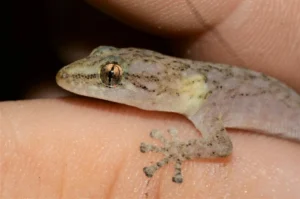
In the wild, those pheromones travel through the air and help attract females or warn other males to back off.
In captivity, you might not smell them, but the geckos definitely can.
Basically, when the weather warms up, those armpit holes become communication central. It’s like nature’s way of switching on the “I’m ready” signal for breeding.
How Scientists Study These Holes
Scientists are pretty fascinated by gecko pores because they show a whole hidden world of reptile communication that most people never notice.
Researchers sometimes collect the pheromone secretions from geckos to study what chemicals they contain and how they affect behavior.
They’ve found that these chemical signals can:
-
Influence which geckos mate with which
-
Reduce fights by showing dominance
-
Help geckos recognize family members or rivals
Some studies even show that female geckos can tell how strong or healthy a male is just from the smell of his pheromones.
It’s a lot like how some animals choose mates based on scent, except here, it’s coming from those tiny pores under the legs.
It’s wild to think that something so small can carry so much information.
Interesting Facts About Gecko Pores
Here are some fun, surprising facts about those “armpit holes” that make geckos even more interesting:
-
In some species, males will “over-mark” areas where females have walked, trying to cover up another male’s scent.
-
The pheromones are species-specific, so a leopard gecko won’t care about the scent left by a crested gecko. Each one speaks its own chemical language.
-
Female geckos can often tell how strong or attractive a male is just by his pheromones.
-
In some cases, scientists can identify what kind of gecko they’re studying just by counting or looking at the pores.
These small details show how clever and detailed the gecko world really is, it’s full of hidden messages that we’d never know about unless we looked closely.
Watching Geckos Without Disturbing Them
If you ever want to watch your gecko using its pores, patience is key. You don’t have to touch it or pick it up, just observe.
Watch for moments when your gecko rubs its thighs or tail base against walls, hides, or branches. That’s often it leaving a message.
Males tend to do this more often, especially when they sense another gecko nearby.
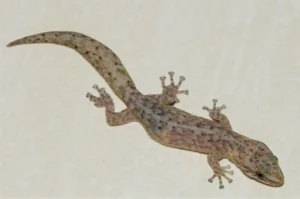
You might see them flick their tails, circle certain areas, or go back to the same spot again and again.
If you handle your gecko, remember to be gentle. Don’t poke or squeeze the pores. They’re sensitive, and overhandling can stress the animal.
Too much stress can even make a gecko release more secretions than normal, which isn’t healthy for it.
The best way to enjoy it is just to watch quietly and let your gecko do its thing.
Conclusion
Those tiny holes under a gecko’s front legs might look strange, but they’re far from useless.
They’re actually one of the coolest parts of a gecko’s body, a built-in communication tool that lets them mark territory, find mates, and recognize each other without making a sound.
So the next time you see your gecko stretching its legs or rubbing against a wall, know that it’s not just random behavior. It’s leaving invisible messages only other geckos can read.
For humans, there’s nothing to worry about. These little pores are totally harmless and just another sign of how smart and well-adapted geckos really are.
Hi, my name is Ezra Mushala, i have been interested animals all my life. I am the main author and editor here at snakeinformer.com.

